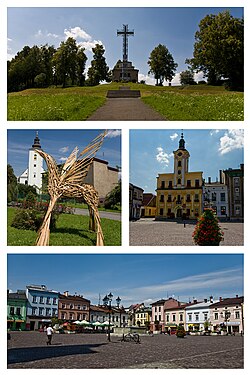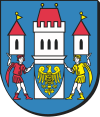Skoczów
| Skoczów | |||
|---|---|---|---|

Top: Papal Cross on Kaplicówka Hill. Centre left: Pegasus statue in front of St Peter and Paul's Church. Centre right: Town Hall. Bottom: Main Square
|
|||
|
|||
| Coordinates: 49°48′2.35″N 18°47′18.16″E / 49.8006528°N 18.7883778°E | |||
| Country |
|
||
| Voivodeship | Silesian | ||
| County | Cieszyn | ||
| Gmina | Skoczów | ||
| Founded | 13th century (?) | ||
| First mentioned | 1282 (?), 1327 | ||
| Government | |||
| • Mayor | Mirosław Sitko | ||
| Area | |||
| • Total | 9.79 km2 (3.78 sq mi) | ||
| Population (2006) | |||
| • Total | 14,641 | ||
| • Density | 1,500/km2 (3,900/sq mi) | ||
| Time zone | CET (UTC+1) | ||
| • Summer (DST) | CEST (UTC+2) | ||
| Postal code | 43-430 | ||
| Car plates | SCI | ||
| Website | http://www.um.skoczow.pl | ||
Skoczów [ˈskɔt͡ʂuf] (German: Skotschau, Czech: Skočov) is a town and the seat of Gmina Skoczów in Cieszyn County, Silesian Voivodeship, southern Poland with 14,783 inhabitants (2004).
The name of the town is of possessive origin, derived from personal name *Skocz.
The town lies in the historical region of Cieszyn Silesia. The very first settlement in the nearest neighbourhood had been established by a Slavic tribe called Golensizi around the 7th century on a naturally defensive hill over the valley of the river Bładnica and ravine called Piekiełko about 2 km (1.24 mi) south-east of the town centre within borders of modern Międzyświeć. The "gord" was later surrounded by an earth bank and moat. The settlement was destroyed in the end of the 9th century most probably by Great Moravian Prince Svatopluk II and was not rebuilt again.
Sometimes the oldest mentioning of Skoczów is believed to be from the document allegedly issued in 1232 by Mieszko, dux Oppoliensis et dominus Tessinensis et Ratiboriensis (implicitly Mieszko II the Fat) for a knight Przecho from Zabłocie, were among witnesses is a ducal writer, Mikołaj from Coczow (Skoczów). Some researchers consider the document to be a fake. Idzi Panic takes into consideration that it could be a mistake during rewriting, and that the document could be originally issued in 1282 by Mieszko, who later ruled the Duchy of Teschen (formed in 1290, where Skoczów also belonged), but back then together with younger brother Przemko ruled Duchy of Racibórz with castellanies of Cieszyn and Oświęcim, and would more likely use the title dux Oppoliensis et dominus Tessinensis et Ratiboriensis than Mieszko II the Fat (who never used as complicated title). The rewriter could have omitted the number L in the year MCCLXXXII (1282), making it MCCXXXII (1232). If the document was indeed a fake, then the first mentioning of Skoczów as oppidum Scocoviense is from 1327 when Duke Casimir I became a vassal of the King of Bohemia. The term oppidum (used also for Jamnica preceding Frýdek) was used in contrary to civitates ruling themselves under German rights of Cieszyn, Bielsko and Frysztat. It probably meant that Skoczów was yet ruled under Polish (ducal) traditional rights.
...
Wikipedia



